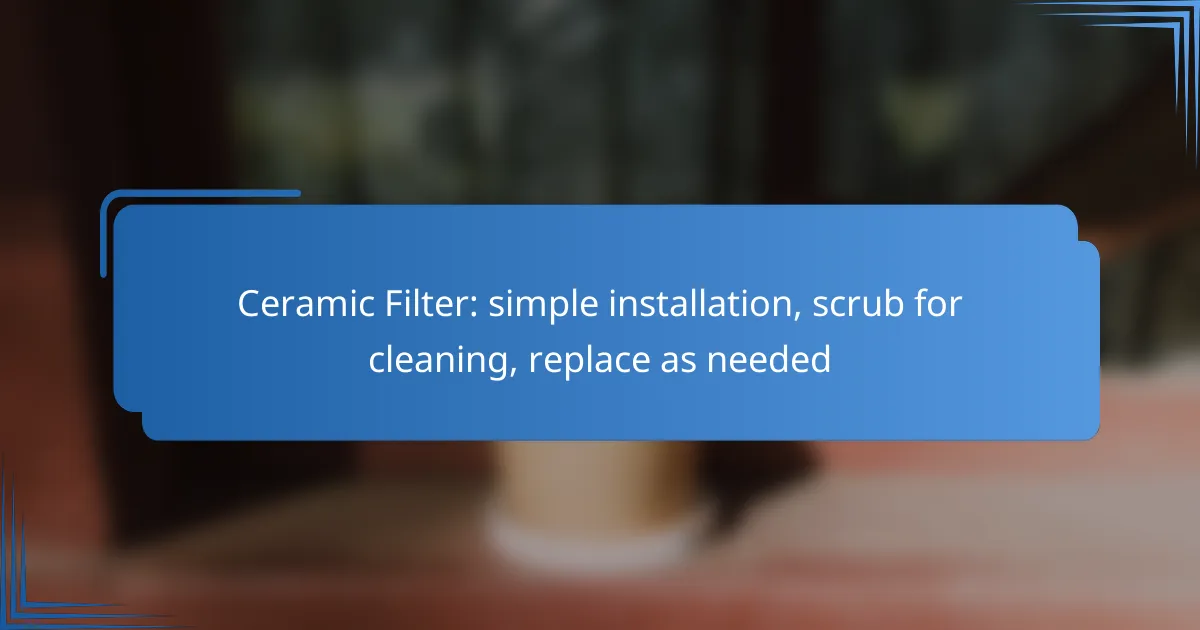Installing a ceramic filter is a simple and effective way to enhance your home’s water quality. With easy setup and straightforward cleaning methods, you can maintain its efficiency and ensure clean water for your family. Regularly checking and replacing the filter as needed will help you enjoy optimal filtration and peace of mind.
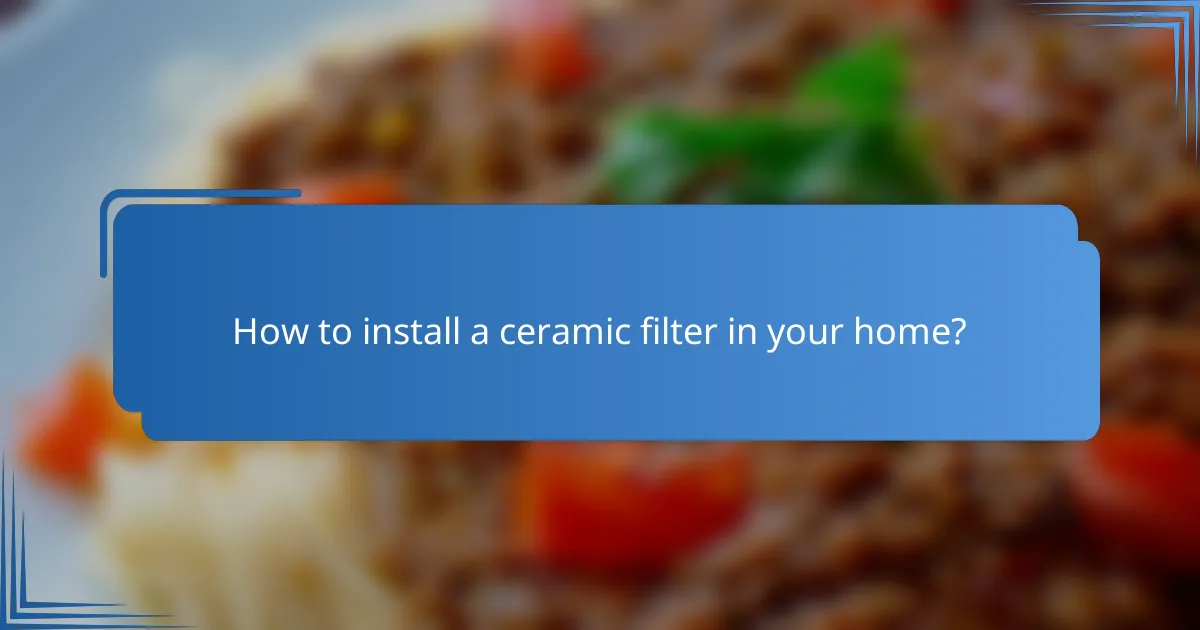
How to install a ceramic filter in your home?
Installing a ceramic filter in your home is a straightforward process that can significantly improve your water quality. With the right tools and a clear guide, you can set it up in a short time, ensuring clean water for your household needs.
Step-by-step installation guide
Begin by selecting a suitable location for the ceramic filter, ideally near your water supply. Ensure the area is clean and dry to facilitate installation. Next, follow the manufacturer’s instructions to connect the filter to your plumbing system, typically involving attaching it to the faucet or under the sink.
Once connected, run water through the filter for a few minutes to flush out any residual particles. Finally, check for leaks and ensure that the filter is securely in place before use.
Tools required for installation
The installation of a ceramic filter generally requires basic tools. You will need a wrench for tightening connections, a screwdriver for securing any brackets, and possibly a utility knife for cutting tubing if necessary.
Additionally, having a bucket on hand can help catch any water that may spill during the installation process. Ensure you have all tools ready before starting to avoid interruptions.
Common installation mistakes
One common mistake is failing to properly tighten connections, which can lead to leaks. Always double-check that all fittings are secure before testing the filter. Another issue is neglecting to flush the filter before use, which can result in unpleasant tastes or odors in your water.
Additionally, ensure that the filter is installed in the correct orientation as specified by the manufacturer. Installing it backward can hinder its effectiveness and may damage the unit.
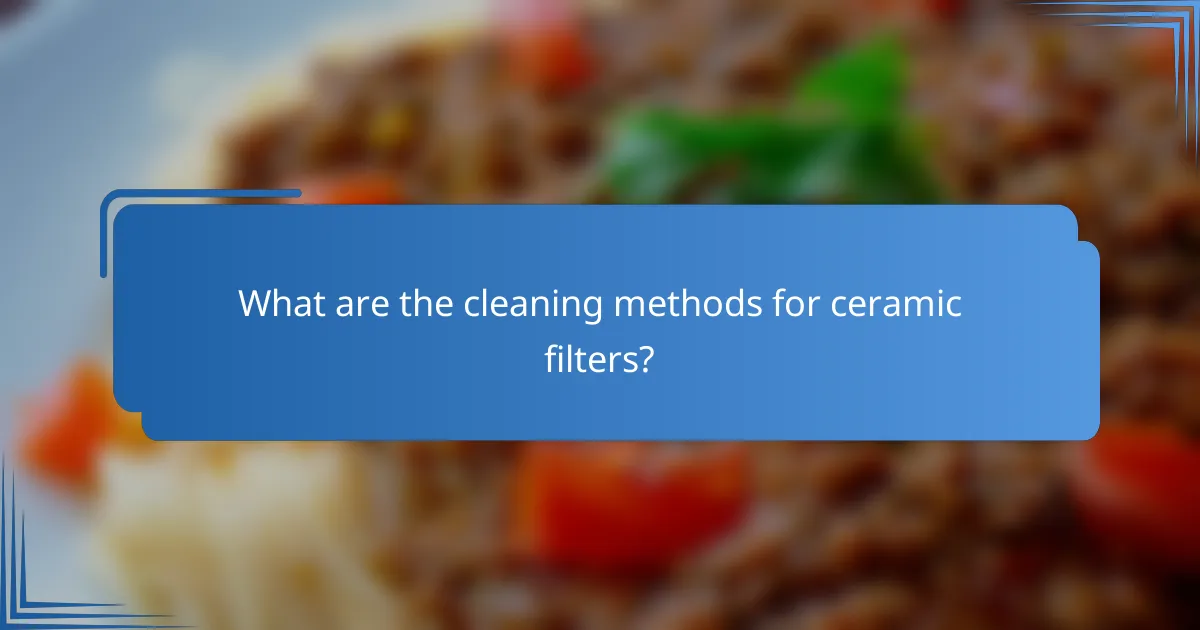
What are the cleaning methods for ceramic filters?
Ceramic filters can be cleaned using various methods to maintain their efficiency and prolong their lifespan. Regular cleaning ensures that contaminants do not clog the filter, allowing for optimal water flow and purification.
Scrubbing techniques for effective cleaning
Scrubbing is a primary method for cleaning ceramic filters. Use a soft brush or sponge to gently scrub the surface of the filter, focusing on areas with visible buildup or discoloration. Avoid abrasive materials that could damage the ceramic surface.
For stubborn deposits, soak the filter in warm water for a short period before scrubbing. This can help loosen any contaminants, making the cleaning process more effective.
Recommended cleaning products
When cleaning ceramic filters, it is advisable to use non-toxic cleaning agents. Mild dish soap diluted in water is often sufficient for routine cleaning. Avoid harsh chemicals that could compromise the integrity of the ceramic material.
Some users prefer vinegar or baking soda as natural alternatives for deeper cleaning. These products can effectively remove mineral deposits without damaging the filter.
Frequency of cleaning
The frequency of cleaning ceramic filters depends on usage and water quality. Generally, it is recommended to clean the filter every few weeks, or more often if you notice a decrease in water flow or an increase in sediment buildup.
Regular checks can help determine the right cleaning schedule. If the filter appears discolored or if water flow significantly slows, it may be time for a thorough cleaning.
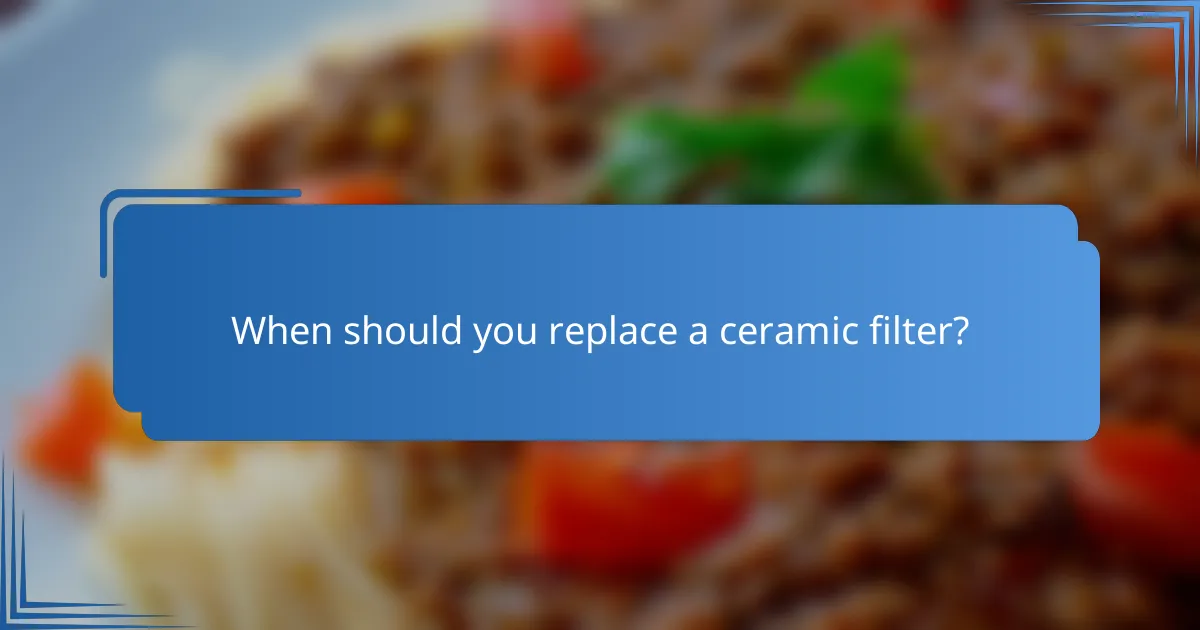
When should you replace a ceramic filter?
You should replace a ceramic filter when its performance declines, typically indicated by reduced water flow or noticeable discoloration. Regular checks can help ensure optimal filtration and water quality.
Signs that indicate replacement
Key signs that a ceramic filter needs replacement include a significant drop in water flow rate and visible dirt or discoloration on the filter surface. If you notice a change in taste or odor of the water, it may also signal that the filter is no longer effective.
Additionally, if the filter has been in use for an extended period, such as several months, it’s wise to inspect it regularly. A good practice is to replace the filter at least every six months, even if no obvious signs are present.
Average lifespan of ceramic filters
The average lifespan of ceramic filters typically ranges from six months to two years, depending on usage and water quality. Filters used in areas with high sediment levels may require more frequent replacement.
To maximize the lifespan, ensure proper cleaning and maintenance. Regular scrubbing can extend the filter’s usability, but always monitor its performance to determine the right replacement timing.
How to dispose of old filters
When disposing of old ceramic filters, check local regulations for waste disposal guidelines. Many areas allow ceramic filters to be disposed of in regular trash, but some may have specific recycling programs.
Before disposal, ensure the filter is thoroughly cleaned to minimize contamination. If possible, consider repurposing the filter for non-potable uses, such as in gardening, where it can help with soil aeration.

What are the benefits of using ceramic filters?
Ceramic filters provide effective water purification by removing contaminants while maintaining essential minerals. They are easy to install, clean, and replace, making them a practical choice for households seeking safe drinking water.
Health benefits of filtered water
Filtered water from ceramic systems can significantly reduce harmful bacteria, viruses, and sediment, leading to safer drinking water. This purification process helps prevent waterborne diseases, which are particularly concerning in areas with inadequate sanitation.
Additionally, ceramic filters retain beneficial minerals like calcium and magnesium, ensuring that the water remains healthy and palatable. Regular use of filtered water can contribute to overall well-being and hydration.
Cost-effectiveness of ceramic filters
Ceramic filters are often more affordable than other water purification systems, with initial costs typically ranging from low to mid-hundreds of USD. Their longevity, often lasting several years with proper maintenance, makes them a cost-effective choice for many households.
Moreover, the savings on bottled water can be substantial. By using a ceramic filter, families can reduce their spending on bottled water, which can add up to significant amounts over time.
Environmental impact of ceramic filters
Ceramic filters have a lower environmental footprint compared to plastic bottled water. By reducing reliance on single-use plastic bottles, they contribute to less plastic waste in landfills and oceans.
Furthermore, the production of ceramic filters generally requires less energy than that of many other filtration systems. This makes them a more sustainable option for those looking to minimize their environmental impact while ensuring access to clean water.

Which brands offer the best ceramic filters?
Several brands are recognized for producing high-quality ceramic filters, known for their effective filtration and durability. Popular options include brands like Berkey, Doulton, and AquaCera, which are often recommended for their reliability and performance.
Top-rated ceramic filter brands
Berkey is renowned for its gravity-fed systems, which combine ceramic filters with activated carbon for superior water purification. Doulton filters are well-regarded for their long-lasting ceramic elements that can be cleaned and reused multiple times. AquaCera offers a variety of ceramic filters that are compatible with different filtration systems, making them versatile choices for consumers.
Other notable brands include Katadyn, which specializes in portable filters ideal for outdoor use, and PurePro, known for its affordable options that still maintain good filtration standards. Each brand has unique features that cater to different needs, from home use to travel.
Brand comparisons and reviews
When comparing ceramic filter brands, consider factors such as filtration efficiency, lifespan, and ease of maintenance. For instance, Berkey filters generally have a longer lifespan compared to others, often lasting several thousand liters before needing replacement. In contrast, Doulton filters require regular cleaning but can be reused extensively, making them cost-effective.
Reviews often highlight Berkey’s superior taste and clarity of filtered water, while Doulton users appreciate the ease of cleaning. AquaCera’s versatility is frequently praised, as their filters can fit various systems, providing flexibility for different setups. Always check user reviews and product specifications to find the best fit for your specific needs.
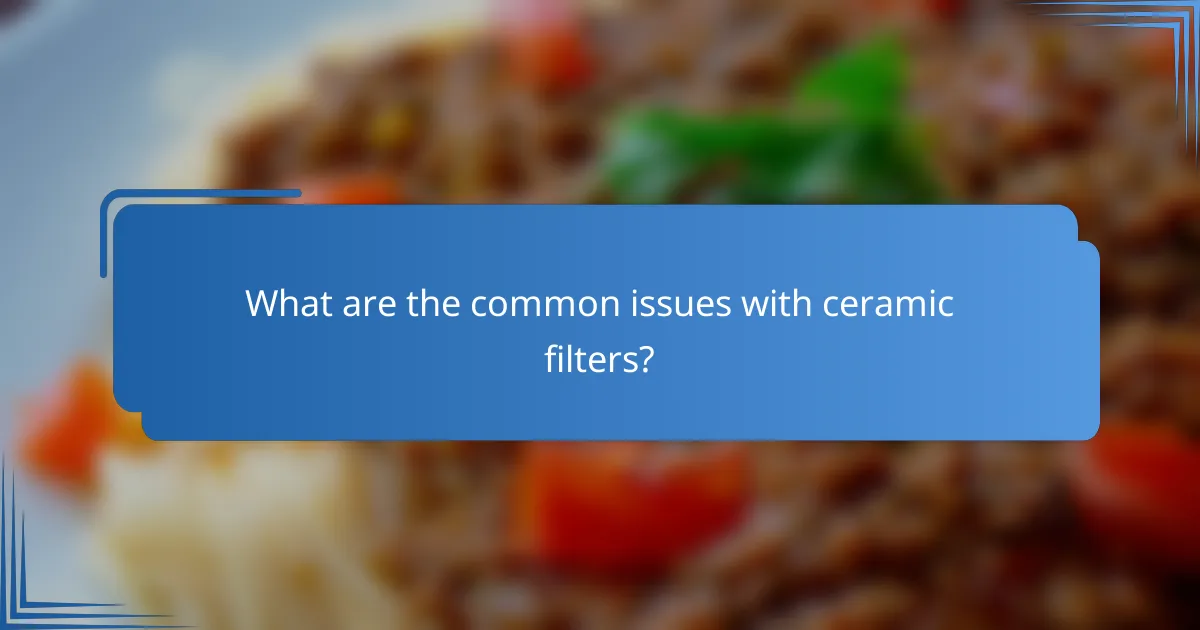
What are the common issues with ceramic filters?
Ceramic filters can face several common issues, primarily related to clogging and performance. Understanding these challenges can help maintain effective filtration and ensure longevity.
Clogging and maintenance issues
Clogging is a frequent problem with ceramic filters, often caused by the accumulation of impurities and sediment. Regular maintenance is essential to prevent this issue; cleaning the filter periodically can enhance its efficiency.
To clean a ceramic filter, simply scrub the surface with a soft brush or cloth under running water. This process should be done every few weeks, depending on usage and water quality. If the filter shows signs of persistent clogging, it may need replacement.
Performance problems and solutions
Performance issues can arise when ceramic filters become clogged or damaged, leading to reduced flow rates and ineffective filtration. If you notice a significant drop in water flow, it’s a clear indicator that the filter requires attention.
To address performance problems, first, clean the filter as mentioned earlier. If cleaning does not resolve the issue, inspect the filter for cracks or wear. Replacing the filter when it shows signs of damage is crucial to maintain water quality and safety.

What are the future trends in ceramic filter technology?
Future trends in ceramic filter technology focus on enhancing efficiency, sustainability, and versatility. Innovations include advanced materials, improved filtration capabilities, and integration with smart technologies for monitoring performance.
Simple installation
Ceramic filters are designed for straightforward installation, often requiring minimal tools and expertise. Many models can be set up in under an hour, making them accessible for both residential and commercial applications.
To install a ceramic filter, ensure you have the right fittings for your plumbing system. Most filters come with clear instructions, and many can be connected directly to existing water lines without extensive modifications.
Scrub for cleaning
Regular cleaning of ceramic filters is essential for maintaining optimal performance. A simple scrub with a soft brush or sponge can remove accumulated contaminants and restore flow rates.
Cleaning should be done every few weeks or when you notice a decrease in water flow. Avoid using harsh chemicals, as they can damage the ceramic material. Instead, use warm water and mild soap for effective cleaning.
Replace as needed
Ceramic filters have a long lifespan, but replacement is necessary when they become damaged or clogged beyond cleaning. Signs that a filter needs replacement include persistent low flow rates or visible cracks in the ceramic material.
Typically, a well-maintained ceramic filter can last several months to a few years, depending on usage and water quality. Regularly check your filter and replace it as needed to ensure safe and clean water.
